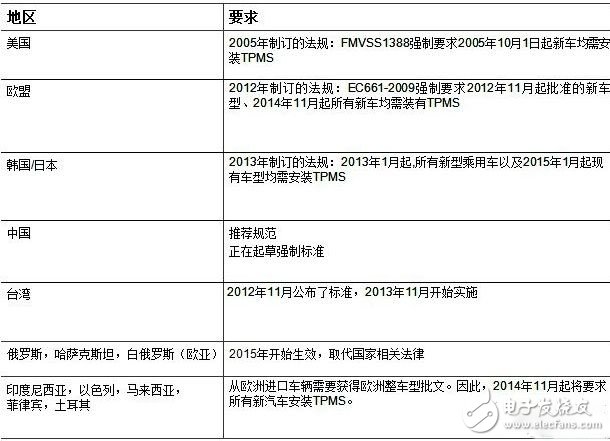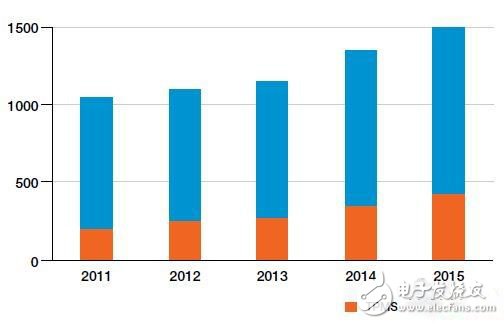introduction
Based on pressure sensing, microcontroller (MCU), radio frequency (RF) and interface technologies required for TPMS, Freescale Semiconductor has been actively involved in tire pressure monitoring for more than 15 years. In 2007, Freescale has not only continued to provide separate components, but also integrated its technology into a single package solution. Recently, Freescale's technology has made new progress, providing an updated single-package solution that leverages advances in microelectromechanical systems (MEMS) and MCU technologies to extend the performance of this integrated solution. This article describes the requirements of the tire pressure monitoring system and the changes to implement the system, as well as the latest technology for system-level packaging solutions, and discusses the technological advances that may occur in the near future.
Good driving
Proper tire pressure is not just about making the tire pressure reach the manufacturer's recommended range. In some cases, it may cause trouble to the driver.
First, the pressure recommended by the manufacturer is a "cold" pressure. The tire pressure is measured after the vehicle is stopped for more than one hour. The measured tire pressure is determined by the load capacity of the tire, and the tire pressure is increased during driving. When the tire gets hot due to driving, the tire pressure measurement should not be lowered to estimate the cold tire pressure, and most tire tire pressures typically increase by about 3-5 psi (20 kPa to 35 kPa) per square inch while driving.
The tire pressure gauge usually measures the difference between the external environmental pressure and the internal pressure of the tire (called gauge pressure). However, the tire pressure is affected by changes in altitude. For example, at high altitudes (such as Flagstaff, Ariz.), when a car with the right tire pressure is driving to a lower altitude (such as Phoenix, Arizona), there will be insufficient air pressure, about 3 psi less (20 kPa). ). Similarly, the pressure on the tires in Phoenix's cold tires will be too high when driving to Flagstaff, about 3 psi (20 kPa).
Seasonal temperature changes are also factors that affect tire pressure. Even if you do not consider the loss of air pressure due to tires that have not been working for a long time (see Safety Considerations), setting the cold air pressure in summer (for example, about 90 °F, about 32 °C) will also be 0 °F (about 0 °F). The winter morning setting of -18 °C) is reduced by approximately 16%.
Without TPMS, drivers who do not check the tires often or in some cases may use tires with abnormal air pressure and are therefore at risk of driving.
Recap history
According to the National Highway Traffic Safety Administration (NHTSA), there are 23,000 traffic accidents involving tire leaks or punctures every year without TPMS, of which 535 are fatal. These two problems may be caused by improper tire pressure. For security reasons, the US government has enacted the Transport Equipment Recall, Improvement, Liability Determination and Documentation Act (TREAD). As part of the TREAD Act, the Federal Motor Vehicle Safety Standard (FMVSS 138) requires that all cars, trucks, and buses with a total weight rating of 10,000 pounds or small quantities must be installed with TPMS since 2008.
The rest of the world is also aware of the safety problems caused by abnormal tire pressure. In France, Sécurité RouTIère estimates that 9% of traffic fatalities are caused by insufficient tire pressure. Germany's DEKRA estimates that tire-related problems account for approximately 41% of all traffic accidents and points out that without TPMS, 75% of vehicles on the road have at least one tire with a deficit of 3 psi (20 kPa) or more.
In addition to improving safety, tires with suitable air pressure can improve the fuel economy of the vehicle. Therefore, TPMS has been requested or will be required in many regions. Table 1 shows the requirements and implementation times for different regions.
Table 1. TPMS regulatory requirements by region

The promulgation of regulations has driven significant growth in TPMS. Market research firm Frost and Sullivan predicts that by 2014, nearly 38% of vehicles in North America will install TPMS. The company expects the number of in-service vehicles installed in Europe to increase to 36.7 million by 2018.
The implementation of TPMS regulations makes tire pressure an important part of automotive stress testing (including manifold absolute pressure (MAP), atmospheric absolute pressure (BAP), airbag pressure, brake pressure, HVAC pressure, etc.). According to IHS iSuppli estimates (Figure 1), by 2015 2TPMS will account for more than 25% of the entire pressure measurement market for automotive sensors.
Figure 1. Total growth of TPMS and automotive pressure sensors. Source: IHS iSuppli Automotive MEMS Market Tracking

figure 1
Product Features
Automatic switch from Boost charge to Floating charge
Constant voltage with current limited
Colorful LCD touch screen - real-time display the working state and running data.
Low output ripple – Makes the charger ideal for all battery types
Full Protection - OVP, OCP, SCP, UTP, reverse connection and other error alarming.
Switching Mode Power Supply,Switching Power Supply,Switching Mode Power Supply 12V,Portable Switch Mode Power Supply
Xinxiang Taihang Jiaxin Electric Tech Co., Ltd , https://www.chargers.be